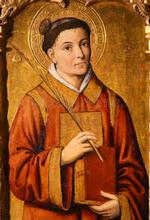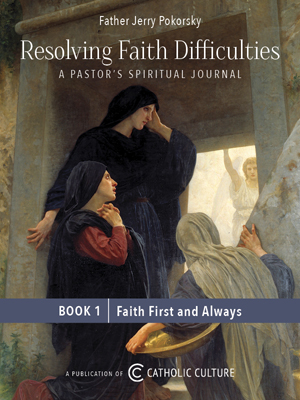Catholic Activity: Bible Stories for Children
Parents can introduce very small children to the Bible by telling them Bible stories (a practice which presupposes that parents will become familiar with the Bible themselves). Here are a few suggestions.
DIRECTIONS
The place to begin is with creation (Genesis 1; 2 — told twice) in the book of Genesis, which means Beginnings. A child's discovery of the wonders of his own world offers endless opportunities for parents to relate to God as Creator the beauties of a garden or a starlit sky. The few difficulties of Genesis are hurdled with a little help, and parents need not fear giving their children a too literal understanding of the story. Since the men who wrote the book existed many thousands of years after it happened, they simply told in their words about God's creating the world.
A few major points are explained as follows:
The six days of creation (Genesis 1; 2:1-3) are a literary device to demonstrate all God's creative action. One child of nine explained it (after having had it explained to him): "It's their way of speaking. You wouldn't put down all the chemicals He used." We say such things as they did. We say: "One-two-three, and he got the job finished!" We do not know exactly how, when and where these first acts of creation took place but until the children ask about this directly, we need not try to explain it.
Why do we read God rested if He never gets tired? (Genesis 2:3) The Hebrew writers said it this way to further impress their people with the sacredness of the Sabbath. They always described God in human terms.
The creation of Eve from Adam's rib (Genesis 2:21-23) is a way of saying that she was of the same flesh as he — the same kind of creature. It is wise to omit the story of the rib or there may be long meanderings on the subject of how many ribs we have, how many on each side, did Adam lose a rib, "I knew a boy and he had a rib taken out," and so on.
"But snakes are good! They eat rats and mice and things that pester farmers!" The serpent (Genesis 3:1-15) used by the writers of Genesis was a symbol of evil. One of the most revolting of the Chanaanite gods was a serpent and he was an ideal figure of the tempter for those Hebrews who were writing the story (it was written after the Exodus) and for those who would learn from it.
The disobedience — was it eating fruit? (Genesis 3:1-14) Perhaps, perhaps not. The point is that Adam and Eve were tested and were disobedient. It does not really matter what they did. In telling the story one should not overemphasize the fruit to the extent that the child misses the story's religious significance.
In the story of Noe, did the flood fill the whole earth? (Genesis 7:11-24; 8:1-5) No, perhaps it only filled the district of the people in the story, but for them it was the world — it was their world. There were many ancient deluge stories and many deluges. The point of this story is that God has an attitude towards good men and evil men. He protects and blesses the good while the evil suffer the punishment due their sins.
In Babel, did they really try to build a tower all the way to heaven? (Genesis 11) This is a symbol of the pride of men who thought they could get along without God. Such towers, called ziggurats, were built in the ancient times, and this was possibly a short story of the pride and failure of men through the centuries, summed up in the story of Babel. We know it was not the origin of the languages, nor of the dispersion of the races; but pride itself is the origin of disunity and contentiousness among men, so in this sense Babel is profoundly true.
We must always ask ourselves one question: "What is God teaching us with this story?"
For example, the point of Adam's naming the animals is that he was their master, that man is the highest of the earthly creatures and all the others serve him (Genesis 2:19). We can think of this when we recall that we name our own pets because we are their masters.
The point of the fall of man, and his inheritance of death, is first of all that he died to God's life in his soul (Genesis 12:15-17; 3:1-5; 19). He did not immediately die in his flesh. It was the death to grace which prompted the redemption and God's promise of a saviour (Genesis 3:14-15).
The point of the sacrifice story of Cain and Abel (Genesis 4:1-7) is that man is the creature and God the Creator, and it matters very much how man approaches his Creator in worship. This story has much to teach us about our attitudes and intentions when we go to Mass. Abel was pleasing to God because his attitude was good; Cain's attitude was not good and God says so right in the story.
God warns Cain that sin has made him weak and he must be on guard against it, and the story of Abel's murder teaches us that we are our brother's keeper (Genesis 4:8-10).
These stories found in the first eleven chapters of Genesis are like God's catechism, and in them we find the first lessons about God, man, grace, sin, worship, pride, punishment, divine love and the promise of redemption. They are ideal for pre-school children and they prepare the way for family Bible reading later on, from the age of about seven through fourteen. Discussed at meal time or other occasions, they relate also to the newly developing interest of the teen-agers in the world about them.
As children grow older they enjoy the stories of the patriarchs and the great heroes of Bible history. But we must always be careful to emphasize the lessons in virtue, trust, hope, obedience, and their relation to God's plan for mankind, or we end up simply with a Bible version of the good guys and the bad guys. Small boys enjoy their hero worship and they relish such stories as Joseph and his brothers (Genesis 37; 39 through 50), and David and Goliath (I Kings 17). Joseph, all alone in a pagan land, resisted temptation and was true to his God, and eventually forgave the brothers who had betrayed him — a fine set of virtues to imitate. One very bright-eyed eight-year-old confided: "I pretend it's happening to me."
David's victory over Goliath can be told with the emphasis on courage, with a reminder that on the hills alone with the flocks, David had to ask the Lord to help him when the lion and the bear tried to kill his sheep. So when he faced the great warrior of the Philistines, small as he was, he cried out: "How dare you defy the armies of the Lord God? Once I killed a lion with the help of God, and once I killed a bear. And with the help of God I'll kill you." And this is how we learn to be brave; we pray to the Lord for His help, and then do what has to be done.
Among other stories enjoyed by the seven-to-ten-year-olds are the call of Abraham and God's promise of a son — teaching lessons in faith, hope, obedience (Genesis 12:1-9; 15:1-20); Abraham and God arguing over Sodom and Gomorra — teaching of God's respect for His friends, how He listens to their prayers in behalf of their brothers (Genesis 18:16-33); Abraham's test, his willingness to sacrifice Isaac — teaching us to trust God and to be steadfast even when we do not understand (Genesis 22:1-19). The book of Exodus is filled with wonderful stories: Moses in the bulrushes; his exile and return to Egypt to struggle with Pharao; the paschal meal; the journey through the Red Sea; the covenant with God on the mountain; the journey through the desert with the miracles of the manna, quails, water, serpents; the arrival at the promised land and the cowardice of the Hebrews; their condemnation to forty years in the desert; and finally the land of Chanaan.
There are many lessons to be learned with the help of these stories out of the Bible but perhaps the one that transcends them all is the revelation of God as our Father, watching over us, caring for us, leading us, for the Israelites in these stories are like figures of ourselves and their strengths and weaknesses are images of our own. Only in the Old Testament is the personality of God the Father revealed so clearly.
Maybe one of the reasons for the frequent overemphasis on baby Jesus in our teaching of children is that we have not known the Father very well, have not known how to teach about Him. But He is found through the Old Testament, His glory veiled by the elements. He appears in the pillar of fire, the pillar of cloud, as a voice in the starry night, in a storm on the mountain, the water from the rock. He broods, creates, corrects, chastises, indulges, forgives — and always He loves. The Hebrews described Him in human terms. They have made knowable and lovable for us the First Person of the Blessed Trinity.
Activity Source: Homemade Christians by Mary Reed Newland, George A. Pflaum, Dayton, Ohio, 1964






